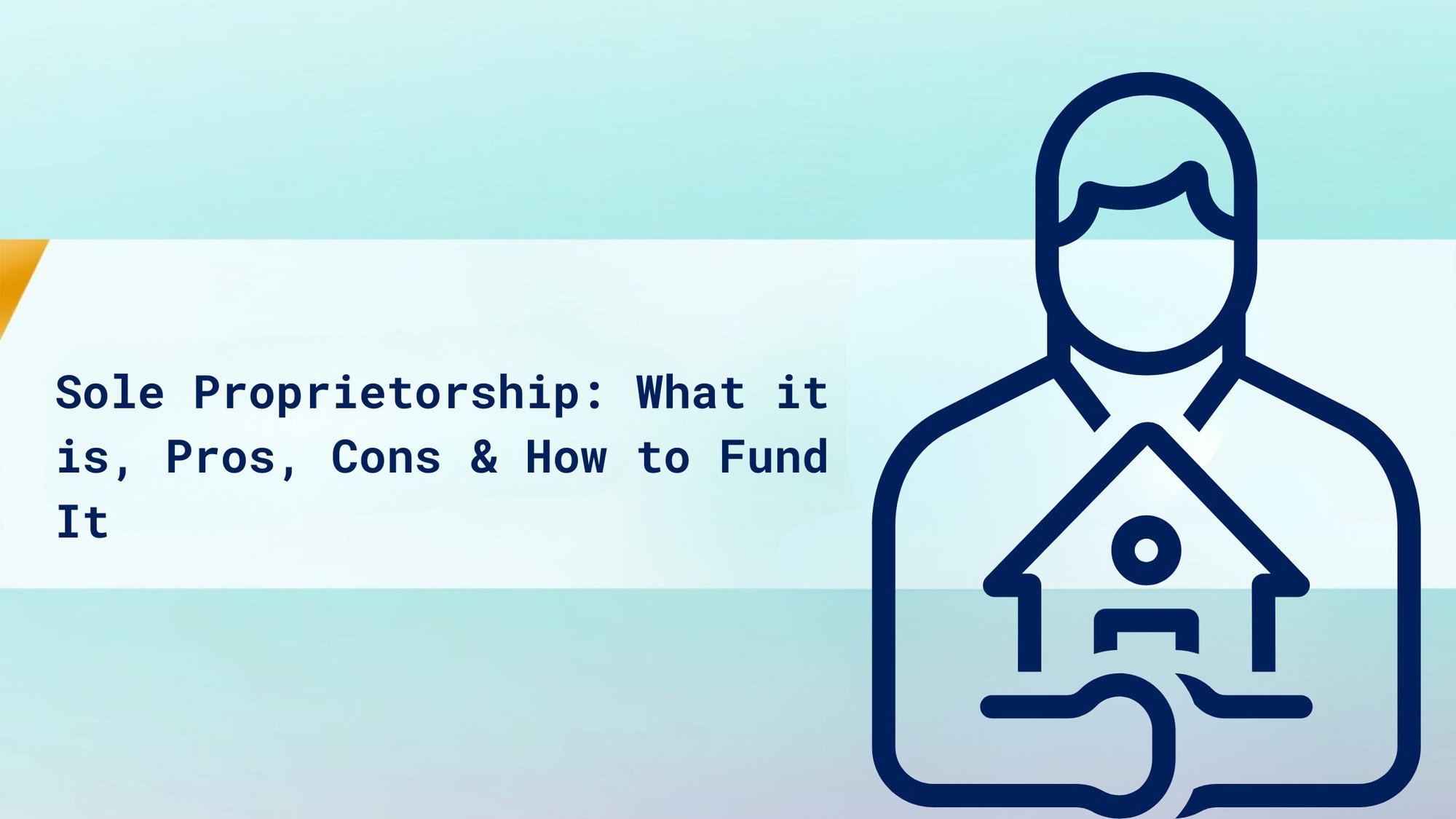
Sole Proprietorship: What it is, Pros, Cons & How to Fund It
Author Taiwo Temitope-Adesope
Sole proprietorship is the simplest and most common structure chosen by individuals starting a business. It refers to a business that is owned, controlled, and operated by one person without needing to formally register with the state as a business entity. Understanding the characteristics of sole proprietorship and its structure is critical for entrepreneurs since it has major implications on personal liability, taxes, management, and funding options.
This blog post will dive into everything an entrepreneur needs to know before starting a sole proprietorship. We'll define what a sole proprietorship is, weigh the major pros and cons, provide tips for financial management and taxes, explore funding strategies, and more. By the end, you’ll have a solid grounding to decide if a sole proprietorship is the right initial business structure for your venture.
Defining Sole Proprietorship
A sole proprietorship is legally defined as a business structure with one owner who fully controls and owns all assets of the business. The sole proprietor and the business are essentially the same entity under the law, unlike structures such as LLCs and corporations which create legal separation between the business and its owners.
Key characteristics of sole proprietorship include:
- No legal business registration required (although permits/licenses may be needed).
- No formal separation between personal and business assets and finances.
- All profit or loss directly flows to the proprietor’s personal tax return.
- Unlimited personal liability for all financial and legal obligations.
Compared to other common business structures, some key differences stand out:
- Sole Proprietorship vs LLC: An LLC requires formal registration and provides personal liability protection that a sole proprietorship lack.
- Partnership vs Sole Proprietorship: Partnerships involve 2+ owners while a sole proprietorship legally has just one.
- Sole Proprietorship vs Corporation: Corporations have much more complex legal and tax implications compared to simple sole proprietorships.
Advantages of a Sole Proprietorship
There are some compelling benefits of sole proprietorship that explain why so many founders use it as an initial business structure:
Simplicity and Ease of Formation
- Extremely simple with no formal registration.
- Can often be set up in just a few days.
- Minimal cost or paperwork requirements.
Complete Control and Decision-Making Power
- No partners to consult or disagree with.
- The owner has the final say on all business matters.
Tax Benefits and Simplified Reporting
- Income and losses flow directly to your personal tax return.
- No need to file a separate business return.
- Allows use of business losses to offset personal income for tax savings.
Profit Retention
- All after-tax profits go directly to your own pocket, no sharing.
Disadvantages of a Sole Proprietorship
While sole proprietorships offer tempting simplicity and ease, there are also some notable downsides:
Unlimited Personal Liability
- As the sole proprietor, you're personally liable for all business debts and legal judgments against your business. This exposes all your personal assets like your savings, home, cars etc.
Challenges in Raising Capital
- Investors know you have unlimited liability, making your business appear riskier.
- Harder to raise external business financing from banks/investors.
- Typically limited to using personal equity or loans in your own name.
But don't let these challenges hold you back! nairaCompare empowers sole proprietors like you to take control of your finances and secure the funding you need to thrive.
With nairaCompare, you can:
- Compare Loans from Multiple Lenders: Access a wide range of loan options from various lenders, ensuring you find the best fit for your business needs.
- Find the Best Rates and Terms: Compare interest rates, repayment schedules, and fees to secure the most favourable loan terms possible.
Ready to take your sole proprietorship to the next level? Visit nairaCompare today and unlock a world of financing possibilities. Don't settle for limited options – compare, choose, and fund your business!

Limited Resources and Expertise
- The buck stops with you for all the core business functions.
- No partners to provide complementary skillsets or expertise.
Potential for Work Overload
- As the solo business owner, workload and responsibilities can become difficult to manage alone.
- Increased vulnerability if you fall ill or need to step away.
Financial Management in Sole Proprietorship
Since personal and business finances are intermingled in a sole proprietorship, managing money responsibly takes on increased importance. Here are some tips:
- Keep Personal and Business Accounts Separate: Have a dedicated business checking account and credit card which helps tracking and monitoring easier for tax purposes.
- Create a Realistic Budget: Carefully plan expected revenue and expenses. Budget for your own salary needs too.
- Build an Emergency Cushion: With no partners to fall back on, aim to have 6+ months of operating costs in a liquid emergency fund.
- Get Business Insurance: Look into general liability insurance or business owner’s policies to get protection from common risks.
- Don’t Co-Mingle Finances: While temptation is there, try your best to not use business funds to pay personal expenses unless you record it properly and account for tax implications.
Funding Sole Proprietorship
As referenced earlier, sole proprietors need to get creative with funding since they have a harder time qualifying for loans or selling company equity to investors. Some options to explore include:
- Personal savings – The most accessible source but limited based on your existing assets.
- Friends/family loans – Raising funds from people close to you who believe in your capabilities.
- Business credit cards – Can leverage 0% introductory rate offers, just be cautious of high long term interest rates.
- Home equity lines of credit – Allows you to access loan funds at lower interest rates backed by your home equity.
- Personal loans/lines of credit – From banks or credit unions, though less favourable loan terms than home equity options.
- Crowdfunding – Creating a campaign to have fans fund your project or idea.
- Retirement account loans – Certain retirement accounts like 401(k)s allow you to borrow against yourself.
- Grants – Government and nonprofit grants exist to specifically help fund small businesses.
As you explore funding options, evaluate interest rates, repayment terms, collateral needed and overall costs to determine the most strategic sources to fuel your early-stage venture.
Transitioning from Sole Proprietorship
Most sole proprietorships eventually elect to transition to alternate business structures as they grow and evolve. Typically, an LLC or Corporation become more suitable as businesses:
- Build up significant business assets in need of liability protection.
- Bring on employees or outside investors/partners.
- Outgrow simplified tax and compliance requirements.
The decision of when to transition is unique to every founder based on their risk tolerance and desire for liability coverage. How to transition simply involves registering your business as the new entity with your state and setting up any required documentation like operating agreements or corporate bylaws. It's encouraged to work with legal counsel to ensure the transition goes smoothly while maintaining continuity of any licenses, insurance, contracts etc.
Conclusion
Starting as a sole proprietorship allows budding entrepreneurs to avoid burdensome registration requirements and make decisions easier without needing consensus from partners. Sole proprietors benefit from full control, direct profit rights, and tax simplicity to start.
However, the risk of personal assets and lack of resources underscore why sole proprietorships eventually transition to more advanced structures for long term stability. By understanding all the core pros, cons and financial considerations covered today though, founders can make smart decisions in launching and operating a lean sole proprietorship early on.
Frequently Asked Questions
Q: Can I legally form a sole proprietorship if I’m not a US citizen or green card holder?
A: Yes, there are no citizenship or residency requirements to form a sole proprietorship. You can own and operate one as a legal foreign resident of the United States on a valid non-immigrant visa like an H1-B or L1.
Q: I’m worried about being personally liable for business debts. What’s my protection?
A: Consider getting an umbrella insurance policy in addition to your business liability coverage to provide an extra layer of protection for your personal assets. Start with at least $1 million in umbrella coverage.
Q: Are there any annual filing requirements or fees to maintain my sole proprietorship?
A: Unlike corporations and LLCs, sole proprietorships have no formal annual state filing requirements after forming. You simply report business activity on Schedule C with your personal tax return.
Q: Can I take on investors or partners later on if I start my business as a sole proprietor?
A: Absolutely. If you start taking investment or adding formal partners, that would necessitate transitioning your sole proprietorship to either a Partnership structure or more formal LLC or Corporation structure.
About Author

Taiwo Temitope-Adesope
Taiwo is a passionate storyteller and strategist dedicated to empowering women and crafting compelling narratives. A First-Class graduate in Mass Communication from Covenant University, she specializes in writing, public relations, and digital marketing. As a Content Manager at Suretree, she drove a 50% increase in web traffic through SEO and boosted website engagement by 60% in just four months. Her leadership experience includes serving as Public Relations Officer for the Covenant University Student Council and contributing to impactful volunteer initiatives. With expertise in strategic thinking and business acumen, Taiwo continues to create stories that inspire confidence and imagination.
.png?width=1615&height=444&name=nairaCompare%20Christmas%20Full%20Logo%20(White%20%26%20Yellow).png)
.png?width=1615&height=444&name=nairaCompare%20Christmas%20logo%20(PNG).png)






.jpg?width=352&name=What%20is%20a%20balanced%20fund%202%20(1).jpg)

